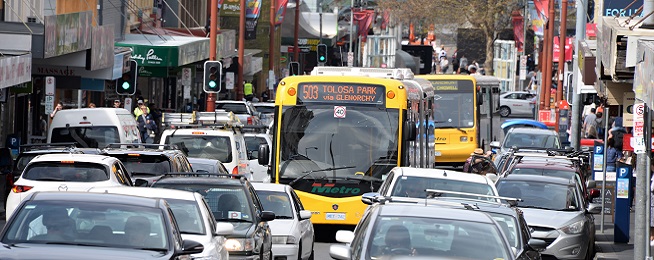The Legislative Council’s inquiry into Hobart traffic congestion has now held public hearings and the submissions are in, as we wait to see what it recommends to solve the capital’s pesky peak hour problems.
Hobart’s peak hour congestion problems should be easily tackled by making it easier to get to and from work and school by options other than private cars.
Bicycle Network made a submission and not surprisingly recommended the construction of separated cycleways to give people another transport option to private cars, as well as an array of policy and behaviour change options to support more people riding.
The experience in every other city around the world shows that if you build a network of separated cycleways and low-speed, traffic calmed roads more people will choose to ride.
The Tasmanian Bicycle Council submitted its plan for separated cycleways through Hobart’s city centre that was released in March this year. The plan proposed a bi-directional separated cycleway that loops around the edges of the centre, providing access to most areas of the city and importantly linking into the Intercity Cycleway and Rivulet Path for a seamless separated ride.
Cycling South, the organisation representing greater Hobart councils, said the increasing traffic congestion was having a negative impact on transport riding, with heavy traffic turning potential riders off.
It recommended six actions: revise the Principal Urban Cycling Network Plan for Hobart, state government to fund cyling infrastructure in the city centre and connectors, 30 km/h speed zones in the city centre, improve pedestrian crossing and traffic signal priority for riding and walking, integrate bikes with buses and change the planning law to mandate end-of-trip facilities.
As well as all the individuals who shared their experiences and support for one of more solutions to traffic congestion, including cycleways, more support for making it easier to ride came from the Heart Foundation, the RACT, the University of Tasmania, Brighton Council, transport consultants MRCagney, and the greater Hobart councils.
The Heart Foundation called for a walkable and cyclable city centre with 30 km/h speed zones and cycle lanes and expanded arterial cycling network, similar in standard to the Intercity Cycleway and eastern shore foreshore paths.
The RACT submitted its Hobart Mobility Vision which it released in April 2019, and recommended separated cycleway routes into and through the city centre.
The University of Tasmania submission backed bikes being carried on buses and ferries, ride and ride parking, bike lanes and a bike share/electric scooter scheme in Hobart’s city centre.
Brighton Council saw the benefits of Hobart having a continuous bicycle network and action plan to make it happen, prioritising bicycle riders and pedestrians when upgrading and designing new streets, and upgrading the Tasman and Bowen bridges to make them friendlier for people riding and walking.
Transport and planning consultants MRCagney pointed out that other Australian cities are building cycling networks to combat traffic congestion, and Hobart needed to identify a new cycling network focusing on separated cycling infrastructure along key spines and consider a bike share scheme.
The four greater Hobart councils supported separated cycleways across their regions and two new cycling bridges connecting Clearys Gates to the other side of the Brooker Highway and lower Collins Street to Macquarie Point.
You can read all the submissions to the inquiry on the committee’s webpage, which is where transcripts of the hearings will also be posted.
Become our friend
Find out more about Bicycle Network and support us in making it easier for people to ride bikes.


